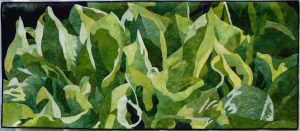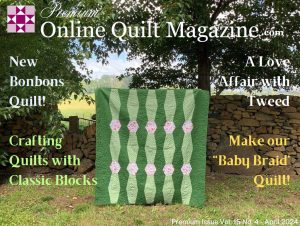

Develop Your Quilting Creativity
November 1, 2023

Hi!
This week we’re travelling back in time with the reprint of a wonderful article by award winning Canadian quilter Elaine Quehl, on ways to develop your quilting creativity, that featured in an earlier issue of our Online Quilt Magazine.
The article might be older, but the wisdom in it is still very much current (and her art quilts are GORGEOUS).
Keep reading and check it all out –
Develop Your Quilting Creativity
“I always say that I was born with the quilting gene.
My mother, grandmothers, and great grandmothers were all quilters, so it would be fair to say that I was destined to make quilts! What I never expected was that one day I would come to design my own quilts, call myself a quilt artist and make a living on the teaching circuit.

It wasn’t until 1996, when I started losing my mother to Alzheimer’s disease, that I signed up for an evening class on traditional quilt making at the local high school. I soon found, however, that I didn’t want to follow patterns exactly, and it was not usually my goal to make a quilt just like the one in the picture.
When I saw my first art quilts at a Canadian provincial show around 2000 I was blown away, and knew that I wanted to design my own quilts that expressed something about me. I had a huge problem though: no one, including me, considered me to be creative. In my family it had always been my sister who was considered creative, showing talent at drawing and painting. Today, however, she is an accountant, and I travel around the country teaching others how to be creative and make their own quilts.

Quilt – “Standing Ovation”
So how did I come to make art quilts?
Simply, through a lot of hard work, otherwise known as practice. I have spent many years working very hard at developing my artistic skills, and I am still working on them today. I think what stood me in good stead was my willingness to experiment and make “mistakes”.
At first I had no end goal in mind, only to make better work and to make my own work.
One thing that has always made my heart sing is value contrast and the illusion of depth in art quilts, and that is what I focussed on most. It wasn’t long before I was teaching, and four years ago I left my conventional job to make a living as a full-time quilt artist, teacher and fabric dyer.
In my classes today I have one rule, and it is that no one is allowed to say “I am not creative”.
I simply do not believe the myth that we are either born creative or we aren’t. We are all creative; some have simply developed their creativity more than others. What I urge students to say instead is “I am working on it (my creativity).”
I would like to share a few suggestions with you about how you can begin to develop your own quilting creativity.

Quilt – “Kissing Joy”
My first suggestion is to keep yourself inspired!
Of course you may not feel inspired every day, but there are a few things you can do to help. Attend an art quilt show, check out some art magazines, including art in other media, visit an art gallery, spend time with nature.
Nature is my biggest source of inspiration, so I always take my camera with me to capture images that inspire me. I prefer to work with my own images so I have no need to worry about copyright permissions, and so that I am working from my own vision. On days when you don’t feel particularly inspired, review these images.
A large part of keeping yourself inspired involves embracing newness and change. I know that I am far more creative when I am in a new environment, so trips and travel often inspire a quilt. But it doesn’t have to be an exotic trip; it could be just a different route to work. Often we don’t even remember driving to work in the morning because we do it every day and don’t even notice the route we take anymore.
I can also tell you that keeping a sketchbook is very good for developing your creativity.
I snip images that inspire me, including my own photographs, then I can create designs, sketch layouts and compositions, and audition colour. You do not have to be good at drawing for this.
The sketchbook is also a very good way for you to record fleeting ideas. Life is busy and we are often multi-tasking, and often a great idea is lost because we don’t write it down. Once we write it down, we save it, and can then build on it later.
I highly recommend taking classes to develop your skills.
If you don’t have suitable classes in your area, there are many on-line classes for art quilters. Once you have a number of techniques under your belt, you will have a tool box to use when you want to express yourself.
But it isn’t just about the techniques. It is also very important to learn about composition and design. There are many good books out there directed specifically at art quilters, and I also found that looking at art in other media helped me to train my eye for better composition. Any art training is going to help you here.
My next suggestion is that you will need to practice, practice, practice.
Not every work you make is going to be a masterpiece!
This is true for all of us. I spend a great deal of time travelling for the purposes of lecturing and teaching. When I deliver my lecture called “Retrospective’, I take audiences through my quilting journey. As I see the images on the screen I am often able to see how my older works could have been improved. I consider many of these older works to be practice pieces that got me to where I am today.

Quilt – “Branching Out”
My final suggestion to you is to pay close attention to the things you tell yourself!
If you have a negative soundtrack running in your head, replace that negative track with something more positive.
For example, if you hear “I’m not creative, I’m no good at this, this looks awful, I’m no artist”, stop right there.
Instead give yourself permission to experiment and keep an open mind about the outcome.
I don’t really believe in using the word “mistakes” to refer to work we consider unsuccessful. These are practice pieces, part of our evolution as an artist. Replace negative thoughts with something that serves you better, like “I’m just beginning, I’m working on my creativity, my work will improve with practice”.
So just keep on practicing!”
Elaine Quehl is an award-winning Canadian quilt artist, teacher, and dyer who specializes in colourful and intricately-stitched pieced and appliquéd art quilts. Elaine’s work has been juried into numerous exhibits at the national and international level, and has been widely published and you can find more on her website http://www.elainequehl.com
I hope you enjoyed this trip down memory lane, and go dig out your sketchbook and start further developing your quilting creativity!
Enjoy!

PS. The lucky winner of our Jelly Jar Fabric Dyeing Course was Mary Ann H., and we look forward to seeing what she makes with her new-found skills!


just love that kissing joy
She reminds me about how I approach quilting.
..she is delightful.